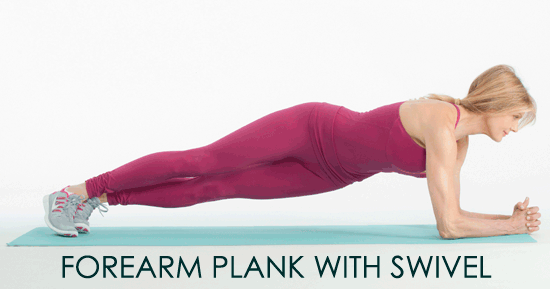Forearm Plank With Swivel
Love ’em or hate ’em, the classic plank is a superhero move for toning your midsection and slimming your waistline. When it comes to fitness, sometimes the simplest moves result in the biggest benefits.
A plank can look misleading, because seems so basic, but it’s actually one of the best exercises for core conditioning.
Adding variations to the classic plank can increase intensity and work the core from different angles. Plus, it’s always fun to have a new challenge!
Try this plank variation that tones your back, abs, glutes, hamstrings, arms, and shoulders all at the same time. That’s a lot of benefits for just one move!
Keep in mind that “the core” is more than just your abdominals. So don’t confuse an ab workout with a core routine!
Your core is what keeps your body stable during any movement or exercise, and it includes dozens of muscles in both the front and back of your abdominal area, around your hips, pelvis and lower back.
Imagine squeezing into a pair of Spanx that runs from your hips to your ribcage. Anything in this area is your core!
Improving your core strength is about more than just vanity. According to the CDC, developing a strong core can improve stability and help prevent back injuries.
FOREARM PLANK WITH SWIVEL
WHAT IT DOES:
- This move is a plank with a twist, a core stabilizing exercise that recruits your obliques for rotation.
DIRECTIONS:
- Start in plank position, but this time, rest on your elbows instead of your hands. Be sure to keep the shoulders depressed back and down and the neck nice and long throughout the movement.
- Keeping your abs engaged, slowly swivel the hips underneath you to the right. Feel your obliques driving this motion as you swivel to the other side with a slow, controlled motion.
BEGINNERS:
- You can modify this movement by resting on your knees instead of full plank position.
ADVANCED:
- Keep your feet stacked and move your toes as you rotate. So as you swivel the hips to the side, you’ll rest your weight primarily on the bottom toe, with the top foot resting on top of it.



